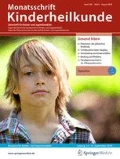Zusammenfassung
Unter Kindern mit chronischer Bronchitis ist die primäre Ziliendyskinesie (PCD) nicht selten. Die Diagnose wird jedoch oft erst im Schulalter gestellt. Dies mag daran liegen, dass ein sensitiver und spezifischer Einzeltest für diese Erkrankung nicht bekannt ist. Im diagnostischen Stufenschema kommt der gezielten Anamnese- und Befunderhebung eine zentrale Rolle zu. Bei den letztlich identifizierten PCD-Patienten findet sich ausnahmslos eine chronische Sekretretention in oberen und unteren Atemwegen, in der Regel schon ab den ersten Lebenstagen. Zur Bestätigung der Diagnose dienen aufwändige Analysen der Zilienfunktion und -struktur. In der Behandlung der PCD steht die Sekretelimination per Physiotherapie im Vordergrund. Bewährt haben sich die autogene Dränage und die regelmäßige Anwendung der Nasendusche. Der individuelle Nutzen von Antibiotika, DNase, Bronchodilatatoren und topischen Steroiden ist durch gezielte Therapieversuche zu ermitteln. Die Betreuung von PCD-Patienten in spezialisierten multidisziplinären Zentren empfiehlt sich.
Abstract
Primary ciliary dyskinesia (PCD) is not rare among children with chronic bronchitis. However, in many cases it is not diagnosed until the patients reach school age. One reason may be the lack of any single sensitive and specific test for it. A stepwise diagnostic approach must include purposeful elicitation of the history and examination, which are important to identify typical symptoms and signs. In each patient who is finally diagnosed with PCD mucus retention can be found in both the upper and the lower airways, in most cases even in the first days of life. The diagnosis should be confirmed by elaborate analyses of ciliary function and structure. In the treatment of PCD the role of physiotherapy to remove secretions from the airways is crucial. Autogenic drainage and the regular use of a nasal douche have proved effective. The individual response to antibiotics, DNase, bronchodilators and local steroids needs to be established by therapeutic trials. It is advisable for patients with PCD to be treated in specialist centres.



Literatur
Ellerman A, Bisgaard H (1997) Longituditinal study of lung function in a cohort of primary ciliary dyskinesia. Eur Respir J 10:2376–2379
Bush A, O’Callagham C (2002) Primary ciliary dyskinesia. A nose for a diagnosis? Arch Dis Child 87:363–365
Nüßlein TG, Griese M, Nicolai T (2001) Ziliendiagnostik. Monatsschr Kinderheilkd 49:826–837
Jorissen M, Willems T (2000) Success rates of respiratory epithelial cell culture techniques with ciliogenesis for diagnosing primary ciliary dyskinesia. Acta Otorhinolaryngol Belg 54:357–365
Coren ME, Meeks M, Morrison I et al. (2002) Primary ciliary dyskinesia: age at diagnosis and symptom history. Acta Paediatr 91:667–669
Noone PG, Leigh MW, Sannuti A et al. (2004) Primary ciliary dyskinesia. Diagnostic and phenotypic features. Am J Respir Crit Care Med 169:459–467
Karadag B, James AJ, Gültekin E et al. (1999) Nasal and lower airway level of nitric oxide in children with primary ciliary dyskinesia. Eur Respir J 13:1402–1405
Wodehouse T, Kharitonov SA, Mackay IS et al. (2003) Nasal nitric oxide measurements for the screening of primary ciliary dyskinesia. Eur Respir J 21:43–47
American Thoracic Society (1999) Recommendations for standardized procedures for the online and offline measurement of exhaled lower respiratory nitric oxide and nasal nitric oxide in adults and children—1999. Am J Respir Crit Care Med 160:2104–2117
Baraldi E, Jongste JC de (2002) Measurement of exhaled nitric oxide in children, 2001. Eur Respir J 20:223–237
Baraldi E, Pasquale MF, Cangiotti AM et al. (2004) Nasal nitric oxide is low in early life: case study of two infants with primary ciliary dyskinesia. Eur Respir J 24:881–883
Nuesslein TG, Hufnagel C, Stephan V et al. (2004) Yield of bronchial forceps biopsies in addition to nasal brushing for ciliary function analyses in children. Klin Padiatr 216:238–243
Bush A, Cole P, Hariri M et al. (1998) Primary ciliary dyskinesia. Diagnosis and standards of care. Eur Respir J 12:982–988
Meeks M, Bush A (2000) Primary cilia dyskinesia. Pediatr Pulmonol 29:307–316
Steinkamp G, Seithe H, Nüßlein T (2004) Therapie der Primären Ziliendyskinesie. Pneumologie 58:179–187
Boucher RC (2004) New concepts of the pathogenesis of cystic fibrosis lung disease. Eur Respir J 23:146–158
Shoseyov D, Bibi H, Shai P et al. (1998) Treatment with hypertonic saline versus normal saline nasal wash of pediatric chronic sinusitis. J Allergy Clin Immunol 101:602–605
Böllert FGE, Paton JY, Marshall TG et al. (1999) Recombinant DNase in cystic fibrosis: a protocol for targeted introduction through n-of-1 trials. Eur Respir J 13:107–113
Danksagung
Frau Dr. Nesriye Maiwald (Bochum) und Frau Dr. Christine Thünemann (Bochum) sei vielmals für ihre aktive Mitwirkung am Manuskript gedankt.
Interessenkonflikt:
Der korrespondierende Autor versichert, dass keine Verbindungen mit einer Firma, deren Produkt in dem Artikel genannt ist, oder einer Firma, die ein Konkurrenzprodukt vertreibt, bestehen.
Author information
Authors and Affiliations
Corresponding author
Additional information
Die Empfehlungen zur Therapie der PCD wurden auf einem Expertentreffen zur PCD am 11.09.2003 in Bochum erarbeitet. Die Ausführungen zur Diagnostik basieren auf einem Expertentreffen anlässlich der PCD-Tagung am 09.09.2004 in Nürnberg, moderiert von PD Dr. Peter Ahrens (Darmstadt), Dr. Thomas Nüßlein (Bochum), PD Dr. Heymut Omran (Freiburg), Dr. Horst Seithe (Nürnberg).
Rights and permissions
About this article
Cite this article
Nüßlein, T.G., Rieger, C.H.L. Primäre Ziliendyskinesie. Monatsschr Kinderheilkd 153, 255–261 (2005). https://doi.org/10.1007/s00112-005-1089-2
Issue Date:
DOI: https://doi.org/10.1007/s00112-005-1089-2

